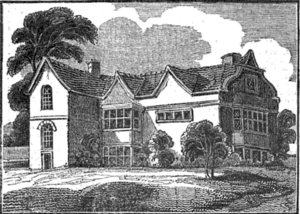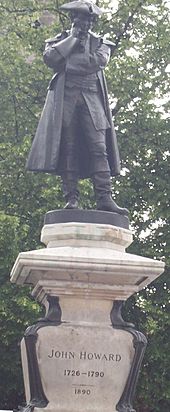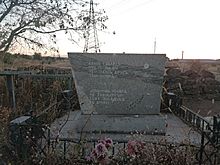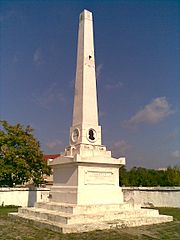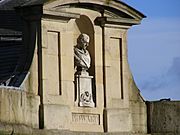John Howard (prison reformer) facts for kids
John Howard FRS (2 September 1726 – 20 January 1790) was a kind-hearted person who worked to improve the lives of others. He was an early English prison reformer, meaning he tried to make prisons better and fairer for everyone.
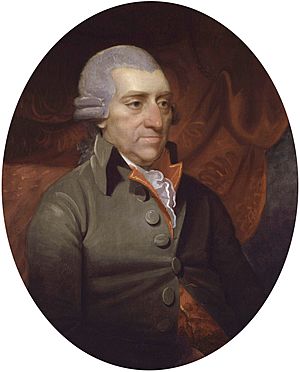
by Mather Brown
Contents
John Howard's Early Years
John Howard was born in North London, either in Hackney or Enfield. His father, also named John, was a rich upholsterer (someone who makes and repairs furniture) in London. John's mother died when he was only five years old. He was described as a "sickly child" and was sent to live in Cardington, Bedfordshire, about 50 miles from London. His father owned land there.
His father was strict and very religious. He sent young John to a school in Hertford. After that, John went to another special school in London.
After school, John started training with a wholesale grocer to learn about business. But he wasn't happy with this job. When his father passed away in 1742, John inherited a lot of money. He was a quiet, serious person with strong religious beliefs, but he didn't have a clear career path yet.
Travels and a Life-Changing Experience
In 1748, John Howard left England for a big trip around Europe. When he came back, he lived in Stoke Newington. He became very ill again. His landlady, Sarah Loidore, took care of him until he was well. He then married her, even though she was 30 years older. Sadly, she died within three years.
After this, Howard decided to travel to Portugal because of a huge earthquake that happened there in 1755. On his journey, his ship was captured by French privateers (private ships allowed to attack enemy ships). He was held in a prison in Brest for six days. Then he was moved to another French prison. Later, he was traded for a French officer held by the British.
This personal experience of being a prisoner deeply affected John Howard. Many people believe this is what made him so interested in improving prisons.
Life in Cardington
After returning from France, John Howard settled down in Cardington. He lived on a large estate that was about 200 acres. He had inherited part of this land from his grandparents. He became good friends with his cousin, Samuel Whitbread.
For the next two years, Howard worked on building homes and trying to make life better for the people living on his land. In 1782, a survey showed that he was paying for 23 children to go to school in Cardington. In May 1756, he was chosen to be a Fellow of the Royal Society, which is a group of important scientists.
John Howard: The Prison Visitor
In 1773, John Howard was chosen to be the High Sheriff of Bedfordshire. This was a job that usually lasted one year. Instead of letting someone else do his work, Howard decided to visit the county prison himself. He was shocked by what he saw. This made him want to inspect prisons all over England.
He was especially worried about prisoners who were held just because they couldn't pay a fee to the jailer. He brought this problem to the government. In 1774, he was asked to speak to a special committee in the House of Commons about prison conditions. This was unusual, and Howard was publicly thanked for his "humanity and zeal" (his kindness and passion).
After visiting hundreds of prisons across England, Scotland, Wales, and other parts of Europe, Howard published his first book, The State of the Prisons, in 1777. The book had very detailed descriptions of the prisons he visited, including maps. It also gave clear instructions on how to make improvements, especially about cleanliness. Many prisoners were dying because of poor hygiene. This book is believed to have started the idea of keeping prisoners in separate cells in the UK and the US.
Here's an example of what he found at a prison called the Bridewell in Abingdon, Oxfordshire:
- Two dirty day-rooms and three bad-smelling night-rooms.
- The men's room was eight feet square.
- One women's room was nine by eight feet, the other was four and a half feet square.
- The straw beds were worn out and full of bugs.
- There was no yard and no water for prisoners.
- Small-time offenders were kept in chains.
John Howard saw his work as helping people. Terry Carlson, who wrote about Howard in 1990, said: "Howard's detailed ideas for improvements were meant to make prisoners healthier, both physically and mentally. They also aimed to make prisons safer and more orderly. His suggestions about where prisons should be, how they should be designed, and how they should be furnished, along with providing enough water and good food for prisoners, helped improve hygiene and health."
In April 1777, Howard's sister died and left him a lot of money and her house. He used this money to continue his work on prisons. In 1778, he spoke to the House of Commons again. This time, they were looking into "hulks," which were old ships used as prisons. Two days after giving his evidence, he was already traveling in Europe again, starting in the Dutch Republic.
By 1784, Howard had traveled over 42,000 miles visiting prisons. He received an honorary degree from the University of Dublin. He was also given the "Freedom of the City of London," a special honor. His fourth and final tour of English prisons began in March 1787. Two years later, he published another book, The State of the Prisons in England, and An Account of the Principal Lazarettos of Europe.
John Howard's Final Journey and Death
John Howard's last trip took him to Eastern Europe and to Crimea. While visiting a prison in Kherson, he caught typhus, a serious illness. He died at the age of 63. He was buried in a walled field in Dophinovka (Stepanovka), about 6 miles north. Even though he asked for a quiet funeral, it was a big event. Many important people attended, including the Prince of Moldavia and several admirals.
When news of his death reached England in February 1790, special coins were made to remember him. One coin had the words "Go forth" and "Remember the Debtors in Gaol" on it.
Awards and Honours for John Howard
John Howard was the first everyday citizen to be honored with a statue in St. Paul's Cathedral in London. Another statue was put up in Bedford. A third memorial, designed by John Haviland, is in Kherson. His face is also carved into the buildings of many Victorian prisons across the UK, like at Shrewsbury. In 1790, he was elected an honorary member of the American Academy of Arts and Sciences.
John Howard's Lasting Impact
Organisations Carrying on His Work
About 80 years after John Howard died, the Howard Association was created in London. Its goal was to find the best ways to treat prisoners and prevent crime. In its first report in 1867, the Association said it was working to promote useful prison labor and end the death penalty. In 1921, this group joined with another to become the Howard League for Penal Reform. Today, the Howard League is Britain's largest organization working to improve prisons.
Non-profit groups in Canada also use John Howard's name. They are called the John Howard Society in different areas. Each society works to find fair, kind, and effective ways to deal with crime. There are now over 60 John Howard societies across Canada.
The Howard Association, a helpful organization started in 1855 in Norfolk, Virginia, United States, was also named after him. There is also a Howard League for Penal Reform in New Zealand. The John Howard Association of Illinois, formed in 1901, checks on prisons and works to make the justice system fair and humane in Illinois.
Samford University in the US state of Alabama was founded by Baptists in 1841 as Howard College. Samford's Howard College of Arts and Sciences is still part of the university today.
Other Tributes
- A statue of Howard is in St Paul's Cathedral, the first for a civilian. A large bronze statue in Bedford was put up in 1890, 100 years after his death.
- A clay bust (a sculpture of his head and shoulders) of John Howard is part of the gatehouse at HM Prison Wormwood Scrubs. Another bust is over the entrance to Shrewsbury Prison.
- The John Howard Pavilion at St. Elizabeths Hospital in Washington, D.C., is a special hospital for people with mental health issues who have been involved in the justice system.
- The John Howard School in Clapton, London (now Clapton Girls' Academy), was named after him.
John Howard's Diet
John Howard was a vegetarian. He became a vegetarian many years before he died. He once said that in his London house, they didn't have "a dozen joints of meat in seven years." He ate a diet of milk, fruit, vegetables, butter, tea, and water. He didn't like fancy foods. He loved tea and carried a kettle with him when he traveled.
When he visited Sweden, Howard found it very hard to stick to his vegetarian diet. This was because people didn't eat many vegetables in the winter, and they were almost impossible to find. His diet was mostly coarse bread. He believed that his vegetarian diet helped him avoid getting "gaol fever" (a type of typhus) that was common in the dirty prisons he visited.
See also
- Morrin Centre
- Penitentiary Act
- Sir Robert Peel


